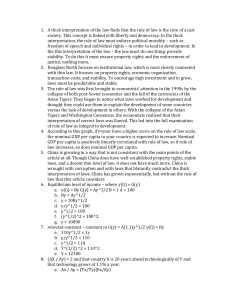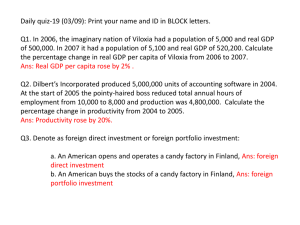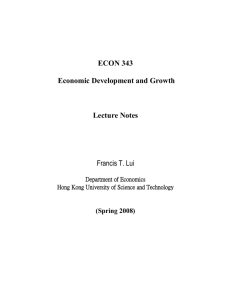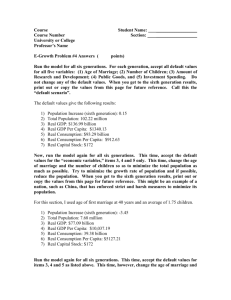E-Growth Exercise #5
advertisement
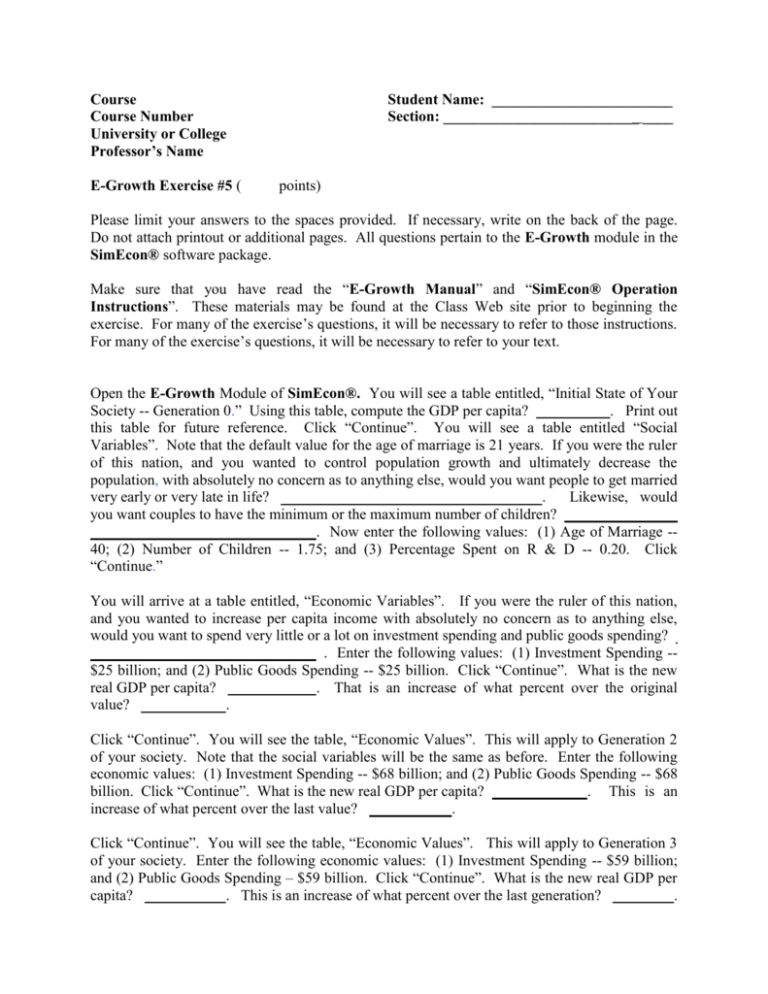
Course Course Number University or College Professor’s Name E-Growth Exercise #5 ( Student Name: ________________________ Section: __________________________ ____ points) Please limit your answers to the spaces provided. If necessary, write on the back of the page. Do not attach printout or additional pages. All questions pertain to the E-Growth module in the SimEcon® software package. Make sure that you have read the “E-Growth Manual” and “SimEcon® Operation Instructions”. These materials may be found at the Class Web site prior to beginning the exercise. For many of the exercise’s questions, it will be necessary to refer to those instructions. For many of the exercise’s questions, it will be necessary to refer to your text. Open the E-Growth Module of SimEcon®. You will see a table entitled, “Initial State of Your Society -- Generation 0.” Using this table, compute the GDP per capita? . Print out this table for future reference. Click “Continue”. You will see a table entitled “Social Variables”. Note that the default value for the age of marriage is 21 years. If you were the ruler of this nation, and you wanted to control population growth and ultimately decrease the population, with absolutely no concern as to anything else, would you want people to get married very early or very late in life? . Likewise, would you want couples to have the minimum or the maximum number of children? . Now enter the following values: (1) Age of Marriage -40; (2) Number of Children -- 1.75; and (3) Percentage Spent on R & D -- 0.20. Click “Continue.” You will arrive at a table entitled, “Economic Variables”. If you were the ruler of this nation, and you wanted to increase per capita income with absolutely no concern as to anything else, would you want to spend very little or a lot on investment spending and public goods spending? . Enter the following values: (1) Investment Spending -$25 billion; and (2) Public Goods Spending -- $25 billion. Click “Continue”. What is the new real GDP per capita? . That is an increase of what percent over the original value? . Click “Continue”. You will see the table, “Economic Values”. This will apply to Generation 2 of your society. Note that the social variables will be the same as before. Enter the following economic values: (1) Investment Spending -- $68 billion; and (2) Public Goods Spending -- $68 billion. Click “Continue”. What is the new real GDP per capita? . This is an increase of what percent over the last value? . Click “Continue”. You will see the table, “Economic Values”. This will apply to Generation 3 of your society. Enter the following economic values: (1) Investment Spending -- $59 billion; and (2) Public Goods Spending – $59 billion. Click “Continue”. What is the new real GDP per capita? . This is an increase of what percent over the last generation? . Course E-Growth Exercise #5 Page 2 Click “Continue”. You will see the table, “Economic Values”. This will apply to Generation 4 of your society. Enter the following economic values: (1) Investment Spending -- $57 billion; and (2) Public Goods Spending -- $57 billion. Click “Continue”. What is the new real GDP per capita? . This is an increase of what percent over the last generation? . Click “Continue”. You will see the table, “Economic Values”. This will apply to Generation 5 of your society. Enter the following economic values: (1) Investment Spending -- $54 billion; and (2) Public Goods Spending -- $54 billion. Click “Continue”. What is the new real GDP per capita? . This is an increase of what percent over the last generation? . Click “Continue”. You will see the table, “Economic Values”. This will apply to Generation 6 of your society. Enter the following economic values: (1) Investment Spending -- $51 billion; and (2) Public Goods Spending -- $51 billion. Click “Continue”. What is the new real GDP per capita? . This is an increase of what percent over the last generation? . Print out the results for Generation 6 for future reference. What was the original real GDP in the beginning? . What is the new real GDP at the end on Generation 6? . That represents an increase of what percent? . Note that this was over six generations. If each generation represents 20 years, what is the average annual percent growth in real GDP over the six generations? . Considering real world figures, does this represent a robust rate of economic growth or does it represent relative stagnation? . What was the original real GDP per capita in the beginning? . What is the real GDP per capita at the end of Generation 6? . That represents an increase of what percent? . Note that this was over six generations. If each generation represents 20 years, what is the average annual percent growth in real GDP per capita over the six generations? Click “Graph” and draw the resulting graph below: Real GDP Per Capita Generations What was the initial population in the beginning? population at the end of Generation 6? decrease of what percent? . What is the . That represents an increase or . Note that this was over six generations. Course E-Growth Exercise #5 Page 3 If each generation represents 20 years, what is the average annual percent increase or decrease in population over the six generations? . Using all these calculations, fill in the following table: Real GDP Real GDP Per Capita Population Generation 0 Generation 6 Percent Change Average Annual Percent Change How does one explain the very slight growth in real GDP versus the very strong growth in real GDP per capita? . By reviewing this exercise, one can compute the total amount spent on investment spending and public goods spending over the entire six generations. What was the total amount investment spending? . If each generation lasts 20 years, what is the average annual amount spent on investment? . What was the total amount spent on public goods? . Likewise, what was the average annual amount spent on public goods? . By spending that much on investment and public goods, there should have been a huge increase in economic growth. Yet the average annual percent increase in real GDP was rather sluggish. Why did this society not reap the benefits of the huge increase in physical capital and public infrastructure? . Look at the table that you printed out at the beginning of this exercise. What was the real consumption per capita? . Now look at Generation 6. What was the real consumption per capita after Generation 6? . What was the percentage increase from the beginning to the end? . Now, compare the real consumption per capita for Generation 6 with the real GDP per capita. What percentage of total real GDP per capita was being spent on consumption goods? . Would you consider this an austere society or a hedonistic society? . In terms of present consumption versus future growth, what is this society attempting to do? What public policy regarding population growth is the People’s Republic of China strictly enforcing? . Will this policy tend to cause that nation’s population to grow very slightly or possibly decline? (Yes, No). Course E-Growth Exercise #5 Page 4 Other things being equal, what impact will this policy have on the per capita income, assuming that the real GDP does not decline? Given the results obtained in this exercise, what are two major drawbacks to this hypothetical nation’s attempt to increase economic growth? ****************************************************************************** Now, completely exit the program and restart the E-Growth module. When you get to the “Initial State of Your Society”, click “Continue”. Enter the following social variables: (1) Age of Marriage -- 14 years; (2) Number of Children -- 10; and (3) Percentage Spent on R & D -0.01. Click “Continue”. Enter the following economic variables: (1) Investment Spending -- $1 billion; and (2) Public Goods Spending -- $10 billion. Click “Continue”. Continue the process for all six generations, using the exact same amounts for each generation. What was the initial population in the beginning (Generation 0)? . What was the population at the end of Generation 6? . What was the percentage increase in population from the beginning to the end? . Given that each generation lasts 20 years, what was the average annual percentage increase in population? . What was the real GDP in the beginning (Generation 0)? . What was the real GDP at the end of Generation 6? . What was the percentage increase or decrease in real GDP from the beginning to the end? . Given that each generation lasts 20 years, what was the average annual percentage increase or decrease in real GDP? . What was the real GDP per capita in the beginning (Generation 0)? . What was the real GDP per capita at the end of Generation 6? . What was the percentage increase or decrease in real GDP per capita from the beginning to the end? . Given that each generation lasts 20 years, what was the average annual percentage increase or decrease in real GDP per capita? . Use the results that you obtained in the last three paragraphs to complete the table below: Population Generation 0 Generation 6 Percent Change Average Annual % Change Real GDP GDP Per Capita Course E-Growth Exercise #5 Do you think that this society performed well over the six generations? Why was there such a huge decrease in real GDP? Why was there such a huge decrease in per capita GDP? What are several changes that this society can make to increase its economic growth? Page 5 (Yes, No).

